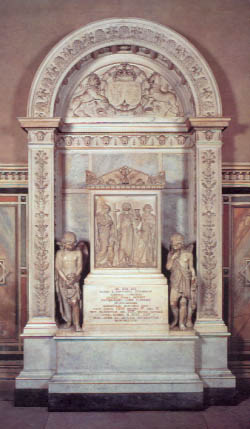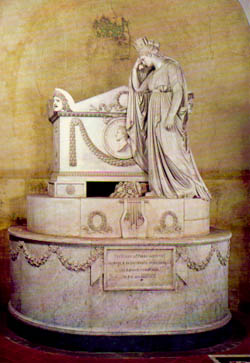 |
 |
 |
 |
 |
 |
 |
 |
 |
A Jacobite Gazetteer - FlorenceBasilica di Santa Croce |
This church is the "Westminster Abbey" of Florence; here are buried many of the city's most important former residents. In the right transept of the church is the Cappella del Santissimo (the Chapel of the Blessed Sacrament, sometimes called the Castellani Chapel). The first monument on the left wall of this chapel is the tomb of Queen Louise (wife of King Charles III) who died in 1824; her body was placed here by decree of the Grand Duke Ferdinand III of Tuscany. The chapel is poorly lit, and therefore the details of the tomb are difficult to see. François-Xavier Fabre (Queen Louise's major heir, and her companion in the last years of her life) commissioned the monument to Louise's memory. The white marble monument measures 4.00 metres high by 2.45 metres wide. Two mourning angels stand one on each side of a funerary stele; the left angel holds a wreath, while the right angel holds a trumpet. The stele has an inscription below, and above, a relief showing the three theological virtues: Faith at the centre (with the cross and chalice) flanked on the left by Charity (with a child in her arms and another at her feet) and on the right by Hope (holding the top of an anchor). At the top of the stele is a winged hour-glass (symbolizing the passage of time and of earthly life). Above the stele are Louise's arms, i.e. the royal arms of Great Britain and the princely arms of Stolberg-Gedern, surmounted by a royal crown, encircled by a wreath, and flanked by the royal supporters. 1 The whole is enclosed within a round arch decorated with various foral motifs. The monument was originally designed by Fabre's friend Charles Perçier. 2 The angels and the stele relief were sculpted by Emilio Santarelli. 3 The other minor details including the arch were sculpted by either Luigi or Ottavio Giovannozzi. 4 Many years before, Count Vittorio Alfieri had composed a Latin inscription intended for Louise's tomb: "A Vittorio Alferio ultra res omnes dilecta et quasi mortale numen ab ipso constanter habita et observata" (Loved above all things by Vittorio Alfieri, and ever held and venerated by him as a semi-divine creature). 5 Fabre, however, did not use this; instead the Latin inscription reads as follows: |
|
ALOISIA. E. PRINCIPIBVS. STOLBERGIIS ALBANIAE. COMITISSA GENERE. FORMA. MORIBVS INCOMPARABILI. ANIMI. CANDORE PRAECLARISSIMA HANNONIAE. MONTIBVS. NATA VIXIT. ANNOS. LXXII. MENSES. IV. DIES. IX OBIIT. FLORENTIAE. DIE. XXIX. MENSES. IANVARII ANNO. DOMINI. M. DCCC. XXIV GRATI. ANIMI. ET. DEVOTAE. REVERENTIAE MONVMENTVM Here lies Louise, born Princess of Stolberg, Countess of Albany, distinguished by birth, beauty, manners, [and] an incomparable brilliance of spirit. Born at Mons in Hainaut, she lived 72 years, four months, and nine days. She died at Florence, January 29, in the year of our Lord 1824. A monument of grateful affection and devoted reverence. |
Half way down the nave in the right aisle, between the monuments to Nicolo Machiavelli and Dante Alighieri, is the funerary monument to Count Vittorio Alfieri (died 1803). It was commissioned by Queen Louise and sculpted by Antonio Canova. 6 On an oval base decorated with a lyre and two wreaths stands a female figure weeping over a sarcophagus; she wears a mural crown (i.e. a crown made of city walls) and represents either Florence or Italy. The top of the sarcophagus is decorated with a poet's laurel wreath in the centre and with a mask of Tragedy and a mask of Comedy at the left and right corners. The front of the sarcophagus is decorated with garlands and with a relief portrait of Alfieri in a round cartouche. Around the portrait is an inscription: VICTORIVS·ALFERIVS·ASTENSI Vittorio Alfieri of Asti Below on a larger oval base there is a Latin inscription which reads as follows:
Several models for the monument as well as an earlier stele version are in the collection of the Museo Canova in Possagno. The basilica is open weekdays 8.00 a.m. - 6.30 p.m. and holidays 3.00 p.m. - 6.00 p.m. (Telephone: 39.055.244619). It is a major tourist site, and it is often necessary to stand in line for some time in order to enter the basilica. Notes 1 The supporters are on the dexter a lion guardant crowned, and on the sinister a unicorn gorged with a coronet (i.e. around the neck) and with a chain affixed thereto passing between the forelegs and reflexed over the back. In this particular rendition of the royal arms, the unicorn seems to have mislaid his horn, and bears a significant resemblance to a horse; the chain too is not affixed in the normal fashion. 2 Charles Perçier was born in Paris in 1764, and died in Paris in 1838. He designed theatre scenery, buildings, and interior decors. Much of his work was done in collaboration with Pierre-François-Léonard Fontaine; they are perhaps best-known for their design of the Arc de Triomphe in Paris. The only work that can with certainty be attributed to Perçier alone is the tomb of Queen Louise. 3 The sculptor Emilio Santarelli (1801-1886) was from Florence. In his will, Fabre left Santarelli all the Alfieri items he had received from Queen Louise; these are now in the Biblioteca e Museo Alfieriano in Asti. 4 The sculptors Luigi Giovannozzi (1791-c. 1870) and Ottaviano Giovannozzi (flourished 1820-48) were from Settignano, a town near Florence. 5 Herbert M. Vaughan, The Last Stuart Queen: Louise, Countess of Albany, Her Life & Letters (London: Duckworth, 1910), 338. 6 Antonio Canova was born in Possagno, near Treviso, in 1757, and died in Venice in 1822. He was the foremost sculptor of his time. In 1819 he completed the monument to the Stuart kings in Saint Peter's Basilica. Early versions of his monument to Alfieri can be seen at the Museo Civico in Bassano and at the Gipsoteca Canoviana in Possagno. Image 1 (Monument to Queen Louise): Luciano Berti, Il Pantheon di Santa Croce a Firenze (Italy: Giunti, 1993), 236. Image 2 (Monument to Count Vittorio Alfieri): Firenze, Santa Croce, Antonio Canova (1757-1822), Monumento a Vittorio Alfieri [postcard] (Florence: Bonechi, 1973).
This page is maintained by Noel S. McFerran (noel.mcferran@rogers.com) and was last updated July 3, 2010. |

